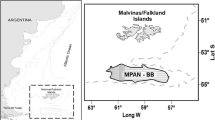Abstract
Prey regurgitation during capture is a potential important confounding effect in fish dietary ecology studies as it may lead to overestimation of stomach vacuity and underestimation of prey consumption. This study investigates patterns of prey regurgitation and stomach vacuity among five grouper and three snapper species in shallow water off French Polynesia and tests the effectiveness of piercing swim-bladders after capture as a method to prevent regurgitation. Groupers exhibited a moderate overall regurgitation rate of 15.6% of full stomachs and a high true (i.e., after accounting for regurgitation) stomach vacuity rate of 40.5%. In contrast, snappers showed high regurgitation (mean 31.7%) and low true stomach vacuity (14.6%). Not accounting for regurgitation would have resulted in a moderate overestimation of stomach vacuity in groupers, but an almost 3-fold overestimation in snappers. Swim-bladder decompression by piercing after capture prove a highly effective method to reduce regurgitation (more than 2-fold for groupers and near 8-fold for snappers). This study enables a more general understanding of prey regurgitation in two commercially valuable fish families, thus improving understanding of the dietary ecology of these fishes. This information is particularly important in the context of prey consumption estimates and subsequent estimations of the impact of fish predators on ecosystems.

Similar content being viewed by others
References
Baum JK, Worm B (2009) Cascading top-down effects of changing oceanic predator abundances. J Anim Ecol 78:699–714
Beukers-Stewart BD, Jones GP (2004) The influence of prey abundance on the feeding ecology of two piscivorous species of coral reef fish. J Exp Mar Biol Ecol 299:155–184
Bowman RE (1986) Effect of regurgitation on stomach content data of marine fishes. Environ Biol Fish 16:171–181
Coleman FC, Koenig CC, Huntsman GR, Musick JA, Eklund AM, McGovern JC, Chapman RW, Sedberry GR, Grimes CB (2000) Long-lived reef fishes: the grouper-snapper complex. Fish 25:14–21
DeMartini EE, Parrish FA, Ellis DM (1996) Barotrauma-associated regurgitation of food: implications for diet studies of Hawaiian pink snapper; Pristipomoides filamentosus (family Lutjanidae). Fish Bull 94:250–256
Dierking J, Meyer AL (2009) Prey regurgitation in the grouper Cephalopholis argus. J Appl Ichthyol 25:600–602
Dierking J, Williams ID, Walsh WJ (2009) Diet composition and prey selection of the introduced grouper species peacock hind (Cephalopholis argus) in Hawaii. Fish Bull 107:464–476
Haight WR, Parrish JD, Hayes TA (1993) Feeding ecology of deepwater lutjanid snappers at Penguin Bank, Hawaii. Trans Am Fish Soc 122:328–347
Harmelin-Vivien M, Bouchon C (1976) Feeding behaviour of some carnivorous fishes (Serranidae and Scorpaenidae) from Tuléar (Madagascar). Mar Biol 37:329–340
Hartleb CF, Moring JR (1995) An improved gastric lavage device for removing stomach contents from live fish. Fish Res 24:261–265
Heemstra PP, Randall JE (1993) FAO species catalogue. Vol. 16. Groupers of the world (family Serranidae, subfamily Epinephelinae). An annotated and illustrated catalogue of the grouper, rockcod, hind, coral grouper and lyretail species known to date. FAO Fish Synop No. 125 16:382p
Heithaus MR, Frid A, Wirsing AJ, Worm B (2008) Predicting ecological consequences of marine top predator declines. Trends Ecol Evol 23:202–210
Hiatt RW, Strasburg DW (1960) Ecological relationships of the fish fauna on coral reefs of the Marshall Islands. Ecol Monogr 30:65–127
Hobson ES (1974) Feeding relationships of teleostean fishes on coral reef in Kona, Hawaii. Fish Bull 72:915–1031
Hyslop EJ (1980) Stomach contents analysis: a review of methods and their application. J Fish Biol 17:411–429
Kamler J, Pope KL (2001) Nonlethal methods of examining fish stomach contents. Rev Fish Sci 9:1–11
Kingsford MJ (1992) Spatial and temporal variation in predation on reef fishes by coral trout (Plectropomus leopardus, Serranidae). Coral Reefs 11:193–198
Morris AV, Roberts CM, Hawkins JP (2000) The threatened status of groupers (Epinephelinae). Biodivers Conserv 9:919–942
Mumby PJ, Dahlgren CP, Harborne AR, Kappel CV, Micheli F, Brumbaugh DR, Holmes KE, Mendes JM, Broad K, Sanchirico JN, Buch K, Box S, Stoffle RW, Gill AB (2006) Fishing, trophic cascades, and the process of grazing on coral reefs. Science 311:98–101
Olson RJ, Galván-Magaña F (2002) Food habits and consumption rates of common dolphinfish (Coryphaena hippurus) in the eastern Pacific Ocean. Fish Bull 100:279–298
Overholtz WJ (2006) Estimates of consumption of Atlantic herring (Clupea harengus) by bluefin tuna (Thunnus thynnus) during 1970–2002: an approach incorporating uncertainty. Northwest Atlantic Fish Sci 36:55–63
Parrish JD (1987) The trophic biology of snappers and groupers. In: Polovina JJ, Ralston S (eds) Tropical snappers and groupers: biology and fisheries management. Westview, Colorad, pp 405–463
Parrish FA, Moffitt HB (1993) Subsurface fish handling to limit decompression effects on deepwater species. Mar Fish Rev 54:29–32
Pauly D, Christensen V (2002) Ecosystem models. In: Hart PJB, Reynolds JC (ed) Handbook of fish biology and fisheries. Blackwell Science, pp 211–227
Pérez-España H (2003) Ecological importance of snappers in the stability of modeled coastal ecosystems. Ecol Model 168:13–24
Shpigel M, Fishelson L (1991) Experimental removal of piscivorous groupers of the genus Cephalopholis (Serranidae) from coral habitats in the Gulf of Aquaba (Red-Sea). Environ Biol Fish 31:131–138
Symondson WOC (2002) Molecular identification of prey in predator diets. Mol Ecol 11:627–641
Thompson R, Munro JL (1978) Aspect of the biology and ecology of Caribbean reef fishes: Serranidae (hinds and groupers). J Fish Biol 12:115–146
Treasurer JW (1988) Measurement of regurgitation in feeding studies of predatory fishes. J Fish Biol 33:267–271
Acknowledgements
We are grateful to Pascal Ung for field assistance in Polynesia. This study was supported by CNRS (UMS 2978 and UMR 5244). We thank anonymous reviewers who made valuable suggestions to improve the manuscript.
Author information
Authors and Affiliations
Corresponding author
Rights and permissions
About this article
Cite this article
Vignon, M., Dierking, J. Prey regurgitation and stomach vacuity among groupers and snappers. Environ Biol Fish 90, 361–366 (2011). https://doi.org/10.1007/s10641-010-9746-2
Received:
Accepted:
Published:
Issue Date:
DOI: https://doi.org/10.1007/s10641-010-9746-2




